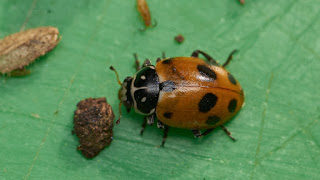After an uneventful but long trip to the north west of Shropshire we gathered in the car park of the village hall in Trefonen and readied ourselves for the visit to the Shropshire Wildlife Trust reserve.
Bwlytai Wood is a small woodland that was given to the Trust by a former resident of Trefonen. The Trust website states that "the bluebells and wood anemones that spill over the ground in spring testify that this is an ancient woodland site".
Unfortunately we were not visiting in spring.
We were hoping to find fungi.
And we had some early success with a couple of finds on dead wood that we could identify and one that we could not.
Dead moll's fingers:
 |
| Photograph: Nigel Cane-Honeysett |
 |
| Photograph: Nigel Cane-Honeysett |
 |
| Photograph: Nigel Cane-Honeysett |
 |
| Photograph: Bob Kemp |
As were invertebrates. There was a long walk (by our standards) from the car park to the wood so we did not take the vacuum sampler with us. A decision that we regretted almost immediately as the more traditional methods of sweeping and beating were ineffective. There was very little ground level vegetation and most of the trees had no low branches that we could reach to beat!
We did manage to find some larvae which we decided were hoverflies, but we had no idea of the species. Here is a photograph of one:
 |
| Photograph: Bob Kemp |
As you walk around it you can see a "window" close to the ground formed when branches have fused.
We lunched and took the decision to go elsewhere. This was the first time in the history of the Joy of Wildlife programme and its predecessors that we had failed to stay at the nominated site.
Nantmawr Quarry and Jones' Rough were just down the road and this is where we went.
I thought that the quarry was now unused and accessible but when we arrived we saw the notice on the gate "Keep out". This confused us as we had been following "brown signs" to the site. What do the brown signs indicate?
No matter, we decided to have a "real" walk by following the first public footpath off the road which would, eventually, take us to Jones' Rough, another Shropshire Wildlife Trust reserve. Before we left the car we did a quick scan of the parking area and found several Large willow aphids sitting on stones.
 |
| Photograph: David Williams |
 |
| Photograph: David Williams |
Amongst the grass we noticed some craneflies with "under-developed" wings. These were female Tipula pagana.
 |
| Photograph: David Williams |
From here the footpath levelled out taking us through another pasture where the views were spectacular even in the hazy conditions of the day.
 |
| Photograph: Bob Kemp |
 |
| Photograph: David Williams |
It is a bit late in the season for butterfly watchers but we did espy a faded Wall and a Small copper posed very nicely in front of a camera.
 |
| Photograph: David Williams |
 |
| Photograph: David Williams |
One last find to report before we made our way home after this historic, curious but enjoyable day. This was the rather elongated beetle Oedemera femoralis.
 |
| Photograph: Bob Kemp |









































































